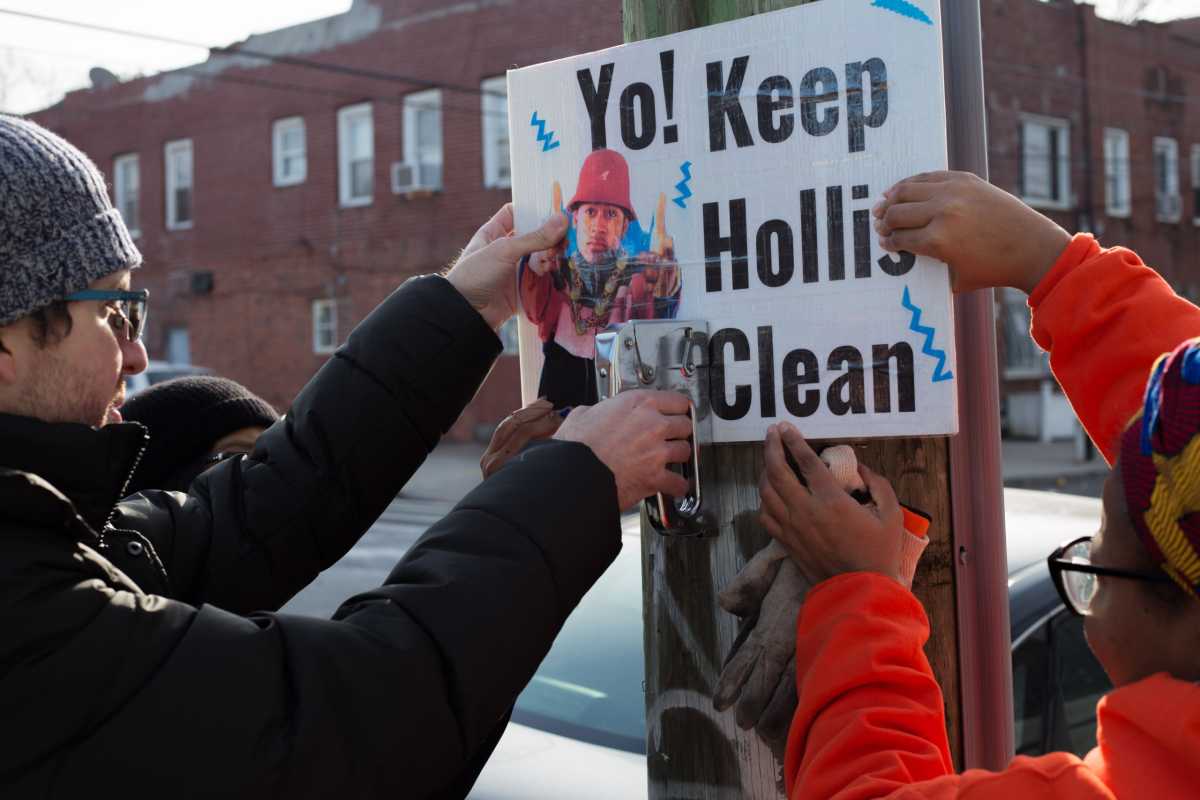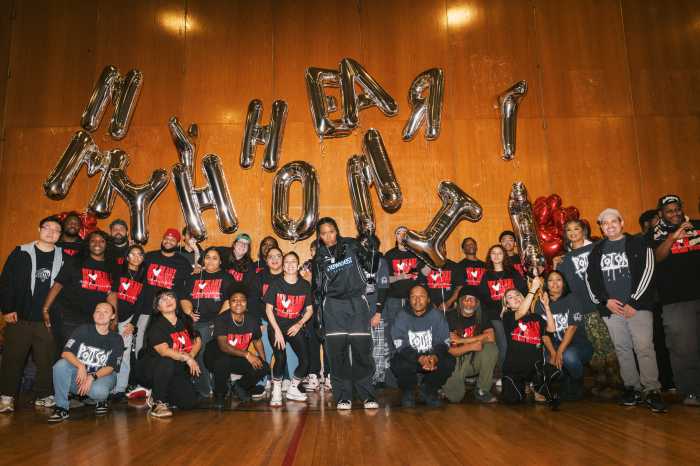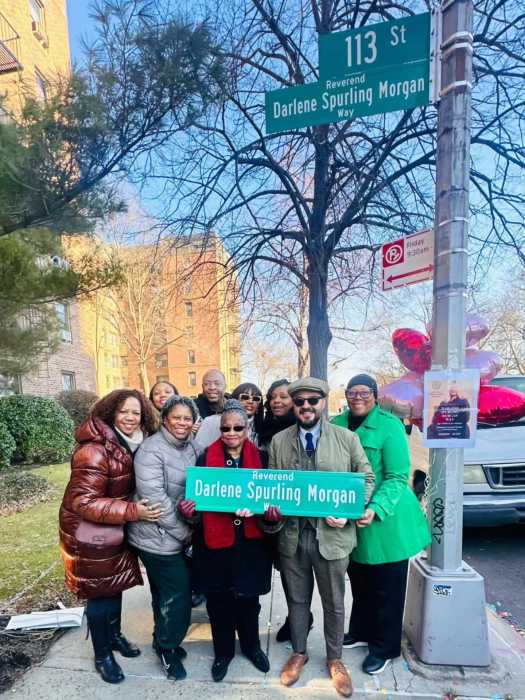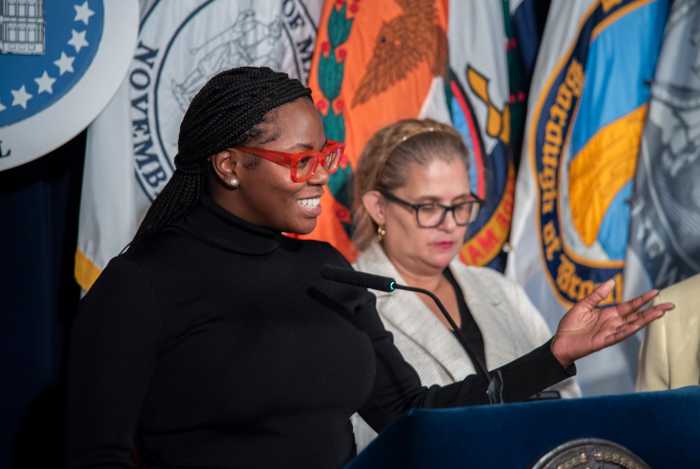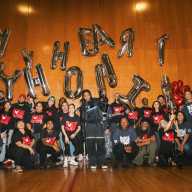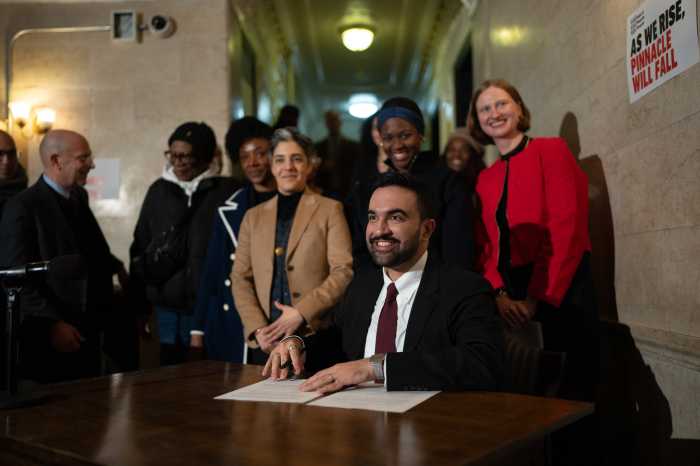This article was originally published on by THE CITY. Sign up here to get the latest stories from THE CITY delivered to you each morning.
In the earliest days of the pandemic, Angela Miskis started to notice piles of trash accumulating around her home and community in southeast Queens.
She couldn’t remain idle for long.
Inspired by her grandmother who picked up trash in her Ecuadorian hometown of Guayaquil, Miskis rolled up her sleeves to clean up her Queens Village neighborhood. As she picked up trash, she eventually ventured farther outside her community, meeting other concerned citizens like herself along the way.
Then she stumbled upon a hot spot for illegal dumping in Hollis — where the Long Island Rail Road tracks run parallel to a patch of dirt and shrubs on 99th Avenue.
“I’m talking like massive piles, like truckloads of illegally dumped trash,” said Miskis, a 34-year-old artist who’s lived in Queens for four years after stints in Harlem and Miami. “And that’s really when I became aware of that area being an issue and how much of an issue it has been for decades.”
Miskis and her band of volunteers formed Abuela Neighborhood Maintenance in April 2020. The group has since organized several clean-up events in Hollis and nearby areas. The name is a nod to Miskis’ abuela, Spanish for grandmother.
To deter dumping on 99th Avenue, Abuela has posted signs featuring Queens hip-hop legends, including Run-D.M.C., Salt-N-Pepa, LL Cool J — and Yoda.
One sign reads: “Litter! Don’t Yerr!” (using Yoda-ese and the New York way of saying “You heard!?”)
Despite efforts large and small to curb the quality-of-life issue, dumpers aren’t deterred. Hollis, Jamaica, South Jamaica and St. Albans are bearing the brunt of the problem.

Queens Community District 12, which encompasses those neighborhoods, is the citywide leader in 311 complaints for illegal dumping, a new category added in September. Previously, it was a minor subcategory under “dirty conditions.”
As of February 22, more than 600 complaints had been filed in CD12 since September, 311 data shows. The area with the next highest amount of complaints, Brooklyn Community District 5, only had 360.
The district also leads in 311 complaints for “chronic dumping,” a subset of the illegal dumping category, with more than 100.
The chief of enforcement for the Department of Sanitation told THE CITY in August that he suspected cheap business owners and construction crews of being a source of the unregulated refuse, with the issue growing during the pandemic as money got tighter and licenses harder to renew.
As for targeting the southeastern Queens neighborhoods, department spokesperson Vincent Gragnani said in a recent statement, “Illegal dumpers generally look for out-of-the-way places to dispose of items, and unfortunately, vacant lots in poorly lighted areas in outer boroughs often fit the bill.”
The heaps of trash have taken a toll on locals, most of whom are Black and brown.
“It’s just demoralizing,” Miskis said. “It’s a middle-class, working-class community, and then you get off the train station after a hard day’s work, and then you’re just confronted with piles of trash.”
The area surrounding the Hollis station isn’t sanitary, she continued, especially the sidewalk under the train trestles, where a layer of bird droppings cakes the ground.
“It’s not healthy,” she told THE CITY. “It doesn’t look nice. You don’t feel nice. Why will you feel proud of calling that area home when it’s so dirty all the time?”
‘Bad Actors’
Southeast Queens neighborhoods have long been plagued by litter and trash dumping.
In 2008, CB 12 pleaded for help in its yearly needs statement: “Dumping is an increasing problem and we ask the Department of Sanitation to increase its stakeout presence in our area. We need additional manpower for street cleaning, dump-outs, and litter basket operations. … This is devastating to our community.”
Not much was done, as needs statements from subsequent years detail.
By 2014, current City Council Speaker Adrienne Adams, then-chair of the community board, told the Daily News that littering and dumping had “only gotten worse.”
Now, as a powerful voice at City Hall, she says the longstanding issue requires “multi-faceted solutions” due to “persistent bad actors.”

“This new Council can take a fresh look at enhancing enforcement and other solutions to better address this issue for my district and those of my colleagues across the city that have been similarly plagued by this issue for too long,” Adams said in a statement to THE CITY last week.
The Council passed legislation in 2018 more than doubling the fines for illegal dumping from a vehicle, she noted. The penalty is now $4,000 for a first-time offender, and the car or truck being dumped from can be impounded, whether or not it is the driver’s property.
“Illegal dumping is a theft of public space that degrades quality of life for those who live nearby,” said Gragnani, the Sanitation spokesperson. “As such, we will write summonses for several thousand dollars if necessary. But what we really want is for all New Yorkers to obey the law so that residents in all five boroughs can enjoy clean, safe streets.”
Within Queens Community District 12, Sanitation officials issued 9 summonses for illegal dumping in 2019, 58 in 2020 and 19 in 2021. None have been issued in 2022.
Yvonne Reddick, who has served as district manager of the local community board since 1994, told THE CITY that the problem is as bad as ever. She said Sanitation officials are “doing the best they can with what they have,” but explained that it’s not enough and additional, targeted enforcement is needed.
“What we need is additional manpower,” Reddick said. “We need additional enforcement. We need a clean-up team for this district.”
Trash Fights
Some dumpers have become violent when confronted by fed-up community members.
Last May, Al-Hassan Kanu, a local resident and then-Council candidate, recorded cellphone video of a broad-daylight dump in progress on 202nd Street and 99th Avenue.
When Kanu approached the truck driver dropping the garbage, the man attacked him, the video shows. A struggle for the phone ensued before the driver got into his truck and sped off.
“He fought me,” Kanu explained in a Facebook video of him at the scene, “because they came here and dropped garbage.”
Kanu went to a hospital and later filed a police report, QNS reported. A spokesperson for the NYPD said no arrests have been made.
In October 2020, State Assemblymember Clyde Vanel tweeted a video of a crew of dumpers, emerging from a truck and unloading trash at the same corner.
LET’S PROTECT OUR COMMUNITY!
Illegal dumping in our neighborhood. on 99th Avenue and 202nd St in Queens. plate NY JRW6355. It was reported to the NYPD, DOT and Sanitation.
Let us know if u know anyone in this group. Let’s route out people treating our community like garbage pic.twitter.com/LchF00AWbc
— Clyde Vanel (@clydevanel) October 6, 2020
That year, Adrienne Adams as a Council member created a “Clean Up Task Force” to convene “community leaders and city agencies to advance solutions, including cameras for chronic hotspots,” she said.
The Sanitation Department ended up installing hidden cameras around well-known illegal dumping sites in Brooklyn last year, THE CITY reported, leading to an arrest and several summonses. But cameras for hotspots in southeast Queens still haven’t been installed.
Adams did secure funding for two cameras, according to her spokesperson, who suggested that THE CITY contact the Department of Sanitation to find out why they have yet to be installed.
In November, former Southeast Queens Councilmember I. Daneek Miller announced nearly $300,000 in funding for cameras and other measures to combat illegal dumping.
Council member Nantasha Williams (D-Queens), who succeeded Miller, said that DSNY officials told her in their last meeting that “they would circle back regarding the status of cameras.”
She said she’s eager to find solutions for local residents.
“When they come outside of their house, and they see trash, they feel very offended by the level of trash and even more offended that no one is doing anything proactive to solve the issue, and it’s a persistent problem,” Williams said.
Gragnani said DSNY has two temporary cameras located in the area, but hasn’t finalized the procurement of permanent ones.
“We expect to have them in place this spring, likely in the next four to six weeks,” he told THE CITY.
At the moment, Reddick said two cameras aren’t enough for such a large area.
“That’s not enough,” she said. “It’s a large district and you have dumping all over the district. I mean, two cameras? That’s just two locations.”
Environmental Justice
Robin Nagle, a New York University professor of anthropology and environmental studies who is the Department of Sanitation’s anthropologist-in-residence, said she suspects dumping occurs more in areas that have less political clout.
“If that means a neighborhood of color or low-income neighborhoods, you immediately are looking at an environmental justice issue, and that’s a big concern,” she said.
Miskis said that when community members have approached elected officials over their concerns about illegal dumping, they would hear the same refrain.
“Usually what you get is just, ‘We’re working on it. We’re aware of the issue, we’re working on it.” Kinda just, ‘hang tight,’” she said.
She added that no elected officials are truly being held accountable.

Abuela Neighborhood Maintenance isn’t the only group stepping up for the community.
In July 2020, Karen “DJ Nett” Lawson was so fed up with the trash in her Jamaica neighborhood, especially in parks as budget cuts hit the Sanitation Department, that she
founded a group called South East Queens Cleanup to fight back.
They have been involved in more than 20 community clean-up events, and recently expanded into beautification, she said.
“On top of cleaning up certain areas and communities, we have started doing projects where we’re actually planting flowers and assisting with murals,” she said.
Like Miskis and Reddick, she commended Sanitation for its efforts to respond to illegal dumps but would like to see increased staffing and more attention paid to hot spots. She said she would also like to see more signage to deter dumpers.
Her group aims to inspire more community members to do their part to keep it clean.
“We just want people to just focus on what they can do,” she said.
THE CITY is an independent, nonprofit news outlet dedicated to hard-hitting reporting that serves the people of New York.

